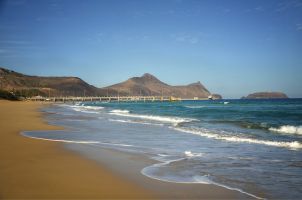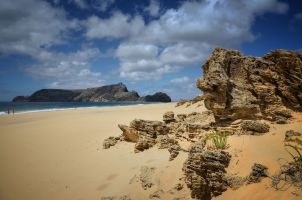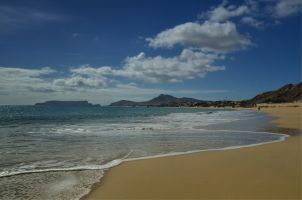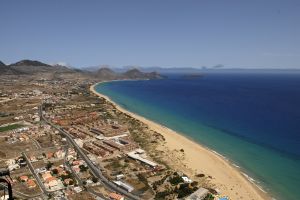 |
Geosite ID: PSt01 Name: Praia Thematic category: Geomorfology, Sedimentology and Paleontology |
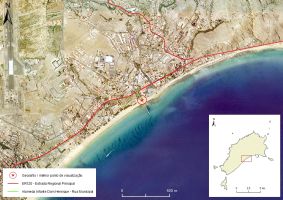 |
Municipality: Porto Santo Civil parish: Porto Santo Location area: 10-1000 ha Coordinates(1):33°03'27.7"N 16°20'04.9"W Altitude: 7 m Accessibility: Easy Distance to nearest paved road: 70 m Conditions of observation: Good (1) Coordinates of the geosite and / or the best viewpoint |
Brief description
Stretching for around 9km, Porto Santo beach is mainly formed by calcareous sand that resulted from the fragmentation of shells, corals and calcareous algae which give it its characteristic yellow colour. Small quantities of dark grains can also be found, which originate from volcanic rocks. The sands result from the erosion of Aeolianites (calcareous sandstones) that occur in the central west region of the island. These deposits cover around 1/3 of the island’s surface and reach a depth of over 40 m at Fonte da Areia. Erosive processes associated with rain and surface runoff towards the south coast of the island are responsible for transporting the sand to the beach.
The sand rests on a rocky base known as lajedo (slab).
Given its physical and chemical properties, the sand has been used in psammotherapy (sand baths) for the treatment of bone and muscular conditions.
Relevant notes
Visiting a site of geological interest is the sole responsibility of the user.
The user must take precautions when visiting the site, taking into account the conditions of the terrain, weather conditions and other hazards, so that they do not create situations that put themselves or others at risk.
The user must respect private property. Access to private areas requires prior authorization from the owners.
The user must respect natural heritage, keeping it intact. The impact of your actions should be minimal.
Protection status
Natural Areas of Recreational Use, according to the Municipal Master Plan.
Bibliography
ANDRADE, C., FREITAS, M., TABORDA, R. & PRADA, S. (2008). Plano de Urbanização da Frente Mar Campo de Baixo – Ponta da Calheta, Porto Santo. Caracterização e diagnóstico, Anexo 8 - Geologia e Geomorfologia Costeira, Dinâmica Costeira, Hidrogeologia. Universidade da Madeira, Faculdade de Ciências de Lisboa, Centro de Geologia da Faculdade de Ciências de Lisboa, 104 p.
FERREIRA, M. R. (2014). Património Geológico da Ilha do Porto Santo e Ilhéus Adjacentes (Madeira): Inventariação, Avaliação e Valorização como Contributo para a Geoconservação. Dissertação de Mestrado em Vulcanologia e Riscos Geológicos. Departamento de Geociências da Universidade dos Açores.
GOMES, C. & SILVA, J. (2001). Beach Sand and Bentonite of Porto Santo Island: Potentialities for Applications in Geomedicine/Areia de Praia e Bentonite da Ilha do Porto Santo: Potencialidades para Aplicações em Geomedicina. Edição dos Autores, 60 p.
MOURA, A. R. (1961). Foraminíferos das areias de praia e dos calcoarenitos da ilha de Porto Santo. Memórias e Notícias, Publ. Museu Lab. Mineral. Geol. Universidade Coimbra, n.º 51, pp. 63-82.
RIBEIRO, M. L. Carta Geológica Simplificada das Ilhas da Madeira e do Porto Santo, na escala 1:80.000 in RIBEIRO, M. L. & RAMALHO, M. (2009). Uma visita geológica ao Arquipélago da Madeira, Principais locais Geo-turísticos. Edição da Direção Regional do Comércio, Indústria e Energia e do Laboratório Nacional de Energia e Geologia, I. P, pp. 55, 82. ISBN: 978-989-96202-0-9.
SILVA, J. (2003). Areia de Praia da Ilha do Porto Santo: geologia, génese, dinâmica e propriedades justificativas do seu interesse medicinal. Madeira Rochas – Divulgações Científicas e Culturais, 344 pp.
How to Cite
FERREIRA, M. R. (2014). Património Geológico da Ilha do Porto Santo e Ilhéus Adjacentes (Madeira): Inventariação, Avaliação e Valorização como Contributo para a Geoconservação. Dissertação de Mestrado em Vulcanologia e Riscos Geológicos. Departamento de Geociências da Universidade dos Açores. In: https://geodiversidade.







